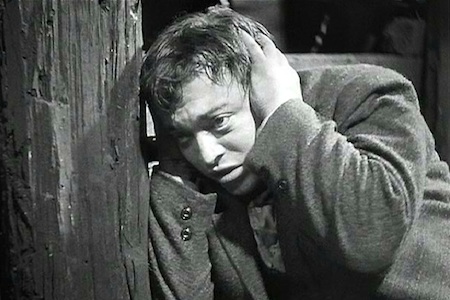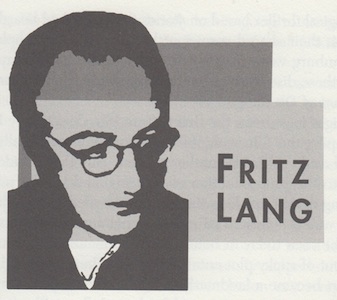Born: December 5, 1890, Vienna, Austria
Died: August 2, 1976, Los Angeles, CA
Hitler was probably the only man who could intimidate him.
—Joan Bennett
Paranoid, vengeful, obsessed, and twisted are a few of the nicest things ever said about Fritz Lang’s movies. As a director who explored the outermost reaches of humanity, he placed himself and his characters in a variety of desperate situations. Because of a rich visual style that ran through his entire body of work, his films remain fascinating to watch. Because of their troubling themes, they have become the finest examples of film noir. The term “film noir” refers to movies whose subject matter contains overtones of obsession, despair, loneliness, and isolation—the darker side of human existence. Defining the person responsible for the genesis of film noir is impossible; the term was coined almost twenty years after the creation of films that critics cite as examples of the style. But Fritz Lang can be considered its most consistent practitioner. His films have given shape to the fuzzy term.
As a young artist, Fritz Lang ditched his architectural classes in 1916 for a chance to write screenplays for the large number of companies just entering Germany’s explosive film industry. Most of Lang’s scenarios were thrillers or horror stories. He set a precedent with a two-part crime story called Spiders (1919), which featured themes of world domination. The film’s success brought Lang a small fortune and prospects of his own production. Joining with Carl Mayer, Hans Janowitz, and Robert Wiene, he worked on a script for a psychological thriller based on stories the group had heard about insane asylums; it was their shared suspicion that many of the people walking the streets of Hamburg were in fact criminally insane and uncaptured felons. The result of these discussions was the schizophrenic and bizarre screenplay for The Cabinet of Dr. Caligari (1919).
Caligari might have been the first feature film directed by Lang. He had begun developing the film with Wiene, who would eventually direct when Lang stepped aside to finish another project. But Lang made a significant contribution to the preproduction of Caligari, and his key addition to the story, a framing device in which the story is revealed to be a dream, is arguably the most widely emulated structural technique among fantasy and horror films. It can be seen today in hundreds of dramatizations, usually as a convenient way out of sticky plot entanglements. When it opened, The Cabinet of Dr. Caligari became a landmark of the German expressionist movement and drew international attention to the country’s finest filmmakers.
Fritz Lang stepped to the forefront of the German film industry with dynamic and striking frame compositions. His early films, among them the dark noir Destiny (1921), had a tremendous influence over directors Alfred Hitchcock and Raoul Walsh. His folk fantasies, Siegfried and Kriemhild’s Revenge, made in 1924, were intended to be seen on consecutive nights, a popular gimmick in theater houses of the day. Lang’s other notable German films included the silent classics Dr. Mabuse (1922) and Spies (1928), both of which received enormous praise.
His stylized, futuristic Metropolis (1926) became another landmark in film history—a science fiction film that has endured as perhaps the finest example of a paranoia film. Capitalizing on the combined fears of rising socialism and growing industrialization, Lang created a world where the individual workers of an underground community are reduced to mechanical cogs in a machine that fuels a rich, sophisticated modern city situated far above. The film established trends in set design, and it predated concepts of a computerized society by thirty years. It remains a seminal influence on every science fiction film made today.
Lang’s next film, Woman in the Moon (1928), gained notoriety when Hitler ordered all prints and negatives of it destroyed. Lang speculated that his movie rockets too closely resembled the weapons that were being built by the German forces. His fear of Hitler became more acute after his transition to sound films. M (1931), starring Peter Lorre, was a film noir masterpiece about a child murderer who confesses to his compulsive criminal behavior. M became Lang’s most famous film to date and drew the attention of Nazi chief propagandist Joseph Goebbels. Looking for a director who could match the effectiveness of Leni Riefenstahl, Goebbels approached Lang in 1934 and asked him to make a series of propaganda films for Hitler. Lang left the country that evening. He stayed in Paris briefly before going to America. Producer David O. Selznick, who had met him on the set of Liliom (1934), signed him to a contract with MGM.
In Hollywood, Lang quickly assimilated the American way of life. He scoured popular magazines to pick up the nuances of the language; he went to parties to improve his English and to develop an ear for the slang and patters of American speech; he traveled throughout the United States to familiarize himself with the history and the geography of his new country. Upon returning to work, he was assigned a series of B movies at MGM and slowly earned the respect of the studio. Soon, he was writing his own scripts again and went back to exploring dark themes in his stories.
Lang’s working methods were rather unorthodox. He was a fastidious daily reader of newspapers and magazines and frequently clipped out small pieces of news or an interesting advertisement for inclusion in a scrapbook. These scraps became the source of much of his material. When reports of a mob lynching in San Jose, California, appearing in newspapers throughout the state, Lang became fixated on the case, using the clippings as the basis of Fury (1936). The finished film, turned into a Spencer Tracy vehicle by MGM executives, received huge praise for its realism and contemporary feel. It started a buzz throughout town about the talents of the studio’s newest director.
Lang remained an offbeat director, resisting big-budget assignment and big stars. Although he was sought after by such leading actors as Marlene Dietrich, Henry Fonda and Glenn Ford, he preferred to develop smaller “no-name” pictures that allowed him room for creative growth. As meddling producers pressed him to make his films more mainstream, Lang seemed determined to explore even darker territory. For the next twenty years, he directed a variety of bleak thrillers that laid the foundation for film noir: Man Hunt (1941), Ministry of Fear (1944), House by the River (1950), The Big Heat (1953), and While the City Sleeps (1956). Lang’s hypnotic visuals also found a natural home among the westerns of the day, most notably Rancho Notorious (1952). Never has another director collected a group of such jaded, shady, desperate characters and wrapped them around plots involving prostitution, blackmail, and drug dealing. Murder almost seems a tolerable habit in a Lang film. Visually stunning, these movies achieve rare moments of artistry that represent the very best of film noir. A typical frame: a femme fatale sits in front of a three-paned mirror while a detective and a thug talk behind her, each panel reflecting a different character to reinforce the triangle of deception that has bound them together.
Lang’s influence was felt immediately. He had tremendous impact on contemporary directors who specialized in thrillers: Alfred Hitchcock, Jacques Tourneur*, Tod Browning, and Otto Preminger. The multitalented Orson Welles confessed to studying the compositions of Lang’s films before making his own debut and relied heavily on the way Lang’s sets architecturally imprisoned the actors for Citizen Kane (1941). A perfectionist who demanded total control over his projects, Lang was fed up with Hollywood in the mid-fifties. When studio interference became unbearable, he suddenly returned to Germany and retired.
As a creative force who was integral in the success of two separate film industries in the prime of their creative output, Fritz Lang is a towering figure in cinema. His collective accomplishments in art direction—the development of German expressionist aesthetic, the creation of the futuristic look of science fiction films, and the introduction of shadowy westerns that dominated the 1940s—are substantial enough to warrant inclusion on a list of influencers. But his prodigious body of film noir standards is clearly the greatest contribution to that genre.
To read all the republished articles from ‘The Film 100,’ as well as the complete list of 100 most influential people in the history of the movies, go to Reintroducing the Film 100 here on Keyframe.
*Editor’s note: Name spelling corrected from original.





